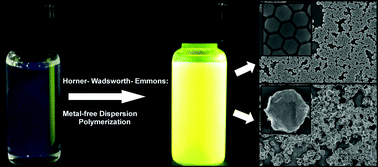Horner–Wadsworth–Emmons dispersion polymerization for the production of monodisperse conjugated polymer particles under ambient conditions†
Abstract
Metal impurities originating from catalyst degradation during synthesis can be detrimental to the optical and electronic properties of conjugated polymer micro- and nanoparticles. Here we present the first metal-free dispersion polymerization protocol affording highly monodisperse conjugated polymer particles via Horner–Wadsworth–Emmons (HWE) coupling. Conveniently, HWE dispersion polymerization is performed under ambient conditions (room temperature, no inert gas). To understand the particle formation process we study the polymerization kinetics, and find that the nucleation event occurs at a conversion of 76%. At this point, the formed polymer chains exhibit a relatively low molar mass with a narrow size distribution, facilitating controlled phase separation and growth into monodisperse conjugated particles. We test two comonomers with different reactivities, namely p-bisphosphonates of perchloro- and perfluorophenylene. Both monomers are copolymerized with a dialkylfluorene dialdehyde resulting in particles composed of poly(arylene-vinylene). Depending on the type of monomer and the reaction conditions, the particle morphology and the emission spectrum can be tuned. Our simple synthetic approach opens up a new and robust route towards metal-free monodisperse conjugated polymer micro- and nanoparticles with good optical properties.



 Please wait while we load your content...
Please wait while we load your content...